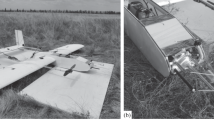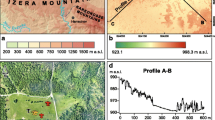Abstract
This paper demonstrates the possibility of using the telemetry of small unmanned aerial vehicles (UAVs) to monitor the state of atmospheric turbulence. The turbulence spectrum is determined from data on the roll, pitch, and yaw angles of the DJI Mavic Mini quadcopter and then compared with measurements of AMK-03 autonomous sonic weather station. The measurements are carried out at the Basic Experimental Complex (BEC) of the Zuev Institute of Atmospheric Optics, Siberian Branch, Russian Academy of Sciences (SB RAS) (Tomsk, Russia), the territory of which has a nearly smooth and uniform surface, on July 24 and August 12, 2020. It has been found that the turbulence spectra obtained with AMK-03 and the DJI Mavic Mini are generally identical with minor discrepancies in the high-frequency spectral range from \(f\sim 1{{\;}}\) Hz. For the data obtained in July, the turbulence spectra in the inertial range obey the 5/3 law, and the relation of measured turbulence spectra of the longitudinal and transverse velocity components corresponds to the Kolmogorov–Obukhov isotropic turbulence. As for the data obtained in August, a slight deviation from the 5/3 law was observed in both AMK-03 and DJI Mavic Mini measurements. The longitudinal and transverse turbulence scales were estimated by the least-square fit method with the von Karman model as a regression curve. The turbulence scales calculated from the July and August data of AMK-03 and the DJI Mavic Mini coincide, and the condition describing the relation between the longitudinal and transverse scales in the isotropic atmosphere stays true to a good accuracy.








Similar content being viewed by others
REFERENCES
L. B. Cornman and W. N. Chan, “Summary of a workshop on integrating weather into unmanned aerial system traffic management,” Bull. Am. Meteorol. Soc. 98 (10), ES257–ES259 (2017).
R. W. Beard and T. W. McLain, Small Unmanned Aircraft: Theory and Practice (Princeton Univ. Press, 2012; Tekhnosfera, Moscow, 2015).
H. W. Tieleman, “Universality of velocity spectra,” J. Wind Eng. Ind. Aerodyn. 56 (1), 55–69 (1995).
I. A. Repina, M. I. Varentsov, D. G. Chechin, et al., “Unmanned aerial vehicles for studying the atmospheric boundary layer,” Innovatika Ekspert.: Nauchn. Tr. 2 (30), 20–39 (2020).
J. Elston, B. Argrow, M. Stachura, D. Weibel, D. Lawrence, and D. Pope, “Overview of small fixed-wing unmanned aircraft for meteorological sampling,” J. Atmos. Oceanic Technol. 32 (1), 97–115 (2015).
R. T. Palomaki, N. T. Rose, M. Bossche, T. J. Sherman, and S. F. J. De Wekker, “Wind estimation in the lower atmosphere using multirotor aircraft,” J. Atmos. Oceanic Technol. 34, 1183–1190 (2017).
J. González-Rocha, C. A. Woolsey, and C. Sultan, “Measuring atmospheric winds from quadrotor motion,” in AIAA Atmospheric Flight Mechanics Conference (Grapevine, Tex., 2017).
B. H. Wang, D. B. Wang, Z. A. Ali, B. T. Ting, and H. Wang, “An overview of various kinds of wind effects on unmanned aerial vehicle,” Meas. Control 52 (7–8), 731–739 (2019).
J. González-Rocha, S. F. J. De Wekker, S. D. Ross, and C. A. Woolsey, “Wind profiling in the lower atmosphere from wind-induced perturbations to multirotor UAS,” Sensors 20, 1341 (2020).
M. Varentsov, V. Stepanenko, I. Repina, A. Artamonov, V. Bogomolov, N. Kuksova, E. Marchuk, A. Pashkin, and A. Varentsov, “Balloons and quadcopters: Intercomparison of two low-cost wind profiling methods,” Atmosphere 12, 380 (2021).
J. Reuder and M. O. Jonassen, “Proof of concept for wind turbine wake investigations with the RPAS SUMO,” Energy Procedia 94, 452–461 (2016).
B. D. Reineman, “Development and testing of instrumentation for UAV-based flux measurements within terrestrial and marine atmospheric boundary layers,” J. Atmos. Oceanic Technol. 30, 1295–1319 (2013).
B. D. Reineman, L. Lenain, and W. K. Melville, “The use of ship-launched fixed-wing UAVs for measuring the marine atmospheric boundary layer and ocean surface processes,” J. Atmos. Oceanic Technol. 33, 2029–2052 (2016).
B. B. Balsley, D. A. Lawrence, D. C. Fritts, L. Wang, K. Wan, and J. Werne, “Fine structure, instabilities, and turbulence in the lower atmosphere: High-resolution in situ slant-path measurements with the DataHawk UAV and comparisons with numerical modeling,” J. Atmos. Oceanic Technol. 35, 619–642 (2018).
A. Rautenberg, J. Allgeier, S. Jung, and J. Bange, “Calibration procedure and accuracy of wind and turbulence measurements with five-hole probes on fixed-wing unmanned aircraft in the atmospheric boundary layer and wind turbine wakes,” Atmosphere 10, 124 (2019).
A. Rautenberg, M. Schön, K. Berge, M. Mauz, P. Manz, A. Platis, B. van Kesteren, I. Suomi, S. T. Kral, and J. Bange, “The multi-purpose airborne sensor carrier MASC-3 for wind and turbulence measurements in the atmospheric boundary layer,” Sensors 19, 2292 (2019).
A. P. Shelekhov, F. L. Afanasiev, A. A. Kobzev, and E. A. Shelekhova, “Opportunities to monitor the urban atmospheric turbulence using unmanned aerial system,” Proc. SPIE: Remote Sens. Technol. Appl. Urban Environ. V 11535, 1153506 (2020). https://doi.org/10.1117/12.2573486.
A. P. Shelekhov, F. L. Afanasiev, A. A. Kobzev, O. S. Chupina, A. E. Tel’minov, and E. A. Shelekhova, “Spectra of turbulent fluctuations of Euler angles of unmanned aerial vehicles in the altitude holding mode,” Proc. SPIE: XXVI Int. Symp. Atmos. Ocean Opt., Atmos. Phys. 11560, 115605 (2020). https://doi.org/10.1117/12.2576773
A. Shelekhov, A. Afanasiev, A. Kobzev, E. Shelekhova, A. Tel’minov, A. Molchunov, and O. Poplevina, “Low-altitude atmospheric turbulence sounding on the basis of unmanned aerial vehicle,” Preprints 2020, 2020090595 (2020). https://doi.org/10.20944/preprints202009.0595.v1
A. S. Monin and A. M. Yaglom, Statistical Fluid Mechanics (Nauka, Moscow, 1967), Vol. 2 [in Russian].
J. C. Kaimal and J. J. Finnigan, Atmospheric Boundary Layer Flows. Their Structure and Measurement (Oxford Univ. Press, Oxford, 1994).
A. A. Azbukin, A. Ya. Bogushevich, V. A. Korolkov, A. A. Tikhomirov, and V. D. Shelevoi, “A field version of the AMK-03 automated ultrasonic meteorological complex,” Russ. Meteorol. Hydrol. 34 (2), 133–136 (2009).
A. A. Azbukin, A. Ya. Bogushevich, A. A. Kobzev, et al., “AMK-03 automatic weather stations, their modifications and applications,” Sens. Syst. 3 (154), 47–52 (2012).
Funding
This work was supported by the Russian Foundation for Basic Research, project no. 19-29-06066 MK.
Author information
Authors and Affiliations
Corresponding author
Additional information
The paper was prepared based on an oral report presented at the All-Russia Conference on Turbulence, Dynamics of Atmosphere and Climate dedicated to the memory of Academician A.M. Obukhov (Moscow, November 10–12, 2020).
APPENDIX
APPENDIX
By analogy with formulas (16)–(18), we define the quantities \({{\alpha }_{{||}}}\) and α using equations
where
The estimates of the longitudinal and transverse components of the wind speed obtained using a quadcopter are defined as
Coefficients \({{a}_{{||}}}\), \({{a}_{ \bot }}\), \({{b}_{{||}}}\) and \({{b}_{ \bot }}\) are determined from the experiment using formulas
where \(\left\langle u \right\rangle \), \(\left\langle v \right\rangle \), \({{u}_{{\max }}}\), \({{v}_{{\max }}}\), \({{u}_{{\min }}}\), and \({{v}_{{\min }}}\) are average, maximum, and minimum values of the longitudinal and transverse components according to AMK-03 data; \(\left\langle {{{\alpha }_{{||}}}} \right\rangle \), \(\left\langle {{{\alpha }_{ \bot }}} \right\rangle \), \({{\alpha }_{{||,~{\text{max}}}}}\), \({{\alpha }_{{ \bot ,~{\text{max}}}}}\), \({{\alpha }_{{||,\;{\text{min}}}}}\), and \({{\alpha }_{{ \bot ,\;{\text{min}}}}}\) are average, maximum, and minimum values of quantities \({{\alpha }_{{||}}}\) and \({{\alpha }_{ \bot }}\). Based on the data of July 24, 2020 \({{a}_{{||}}} = 0.56\), \({{b}_{{||}}} = 0.16\), \({{a}_{ \bot }} = 0.50\), and \({{b}_{ \bot }} = 0\); however, for August 12, 2020, \({{a}_{{||}}} = 0.54\), \({{b}_{{||}}} = 0.06\), \({{a}_{ \bot }} = 0.42\), and \({{b}_{ \bot }} = 0\).
Rights and permissions
About this article
Cite this article
Shelekhov, A.P., Afanasiev, A.L., Shelekhova, E.A. et al. Using Small Unmanned Aerial Vehicles for Turbulence Measurements in the Atmosphere. Izv. Atmos. Ocean. Phys. 57, 533–545 (2021). https://doi.org/10.1134/S0001433821050133
Received:
Revised:
Accepted:
Published:
Issue Date:
DOI: https://doi.org/10.1134/S0001433821050133




